KASP ransomware virus used for money extortion from victims
Contents
KASP is a ransomware-type computer virus that uses RSA cryptography to illegally lock files on victim’s computer, then demand a ransom for their liberation. The infection can be recognized easily as the virus appends .kasp file extensions to modified data and drops _readme.txt notes in every infected folder. The ransom note explains what happened to files and that the victim must pay a ransom worth $490-$980 in Bitcoin to decrypt all files. Victims are instructed to contact the attackers via helpmanager@mail.ch or restoremanager@airmail.cc email as soon as possible. This threat originates from STOP/DJVU malware family which now has released over 250th variants, and is extremely dangerous because it installs AZORULT password-stealer on the system.
KASP ransomware infects computers after users download it in a form of a software crack, mostly. It tries to hide its encryption process by displaying a fake Windows update screen. In this case, users believe that their computers are merely having an OS update and do not try to stop the process. Unfortunately, data encryption is an extremely strong file-locking method that makes encoded information inaccessible for regular use. In other terms, you can only recover encrypted files if you have a unique KASP decryption key.
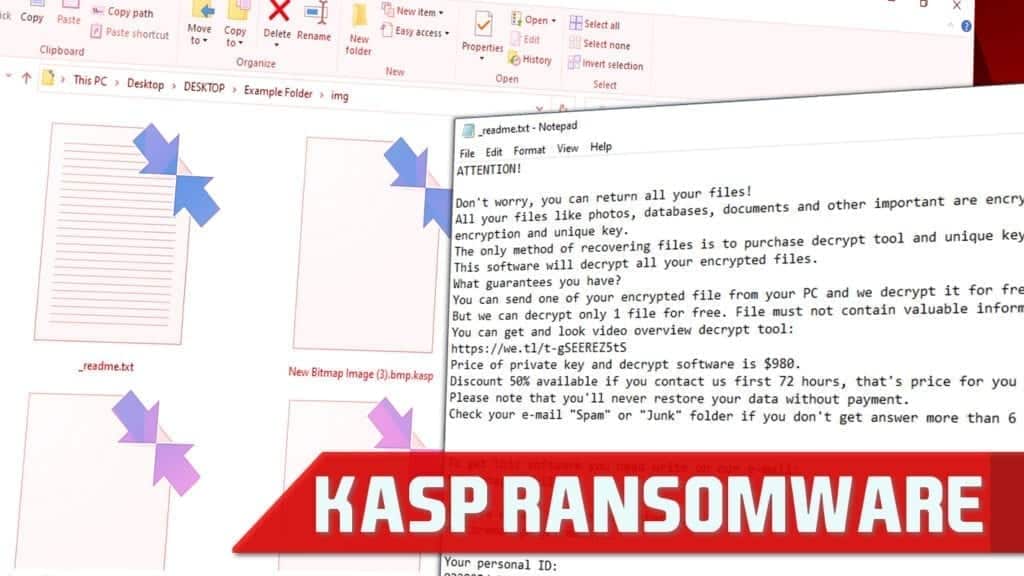
This article contains explanation of how the KASP ransomware operates, what are the chances to decrypt your files and how to remove the virus safely.
What’s inside the ransom note _readme.txt: pay or lose your files
Since cybercriminals are in hold of all important documents once the encryption process is done, they try to extort money from their victims. The _Readme.txt file, which is left by KASP virus in every affected data folder, is also known as a ransom-demanding message that explains what happened to the encrypted data and what to do next. Victims are encouraged to contact the attackers via helpmanager@mail.ch or restoremanager@airmail.cc emails to receive further payment details. Before that, they are demanded to pay $490 within the first 72 hours of the infection or $980 later.
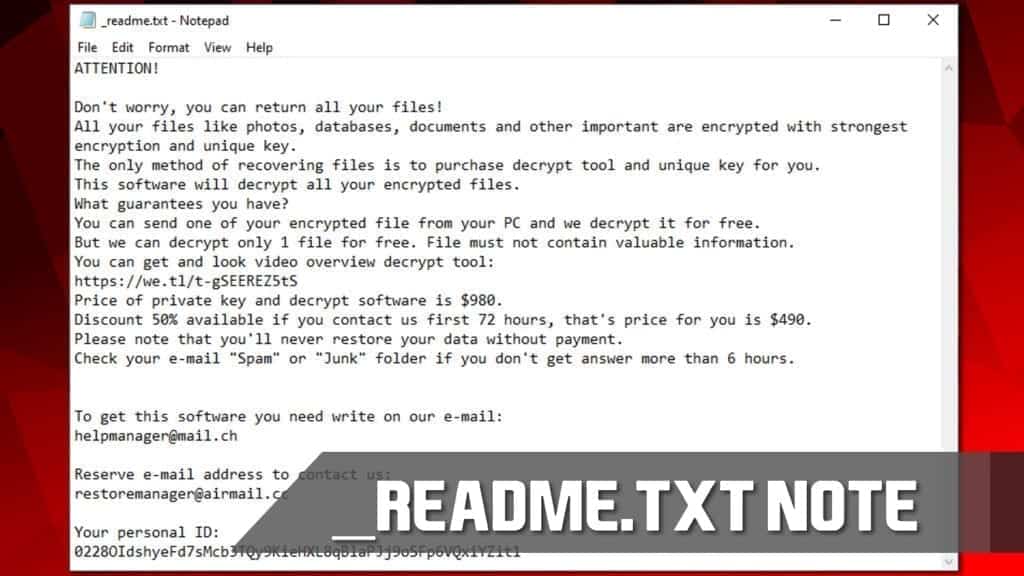
The attackers also suggest testing the decryptor first – they promise to decrypt one small file for free. The victim needs to send it alongside an email to the criminals. However, even if they do decrypt your test file, we have some reasons why you should never pay the cybercriminals.
Do not pay the ransom
Even though paying up to the crooks might seem like the only option here, the majority of them are highly unreliable. They might not only trick you into transferring the money and refuse to deliver the decryption tool later but also try blackmailing to pay more and more money at the end. Likewise, our security experts recommend you remove KASP ransomware virus instead of dealing with the attackers.
Definotely do not listen to criminals’s demands and do NOT pay the ransom! You must check for data backups or KASP decryption tool first.
Scott Bolton
Furthermore, researchers have spotted that this crypto-malware installs a password stealer, known as AZORULT Trojan. As we have already mentioned, cyber criminals are not reliable and only driven by monetary benefits. They can gather your sensitive data and use it for their malicious purposes or sell for third-parties in the underground markets. We strongly suggest you avoid any type of contact with the crooks if you want to avoid financial losses or further damage to your system.
It is very important to check whether you were affected by online or offline encryption, as explained in this STOP/DJVU ransomware guide.
Scott Bolton
For KASP ransomware removal and the elimination of other variants (NPPH, GENO, BOOP, OONN, VARI, NILE, LYLI) we suggest employing a professional malware removal software. While there are numerous different options, we recommend choosing a robust one, like RESTORO. Once you install it, run an entire system scan and clean your computer from the file-encrypting virus and its components. Once the elimination is complete, you can start restoring locked files by using backup copies from the Cloud.
Virus Summary
| Name | KASP ransomware virus |
| Type | Crypto-malware, File-encrypting virus, File Locker |
| Family | STOP/DJVU |
| Other variants | JYPO, KIFR, KIOP, KITZ, BOZA, BOTY, COZA (find full list here) |
| Extension used | .kasp |
| Symptoms | Users receive a deceptive Windows update screen once the encryption process is started; The locked files are marked with a specific extension and cannot be used further; Some people might struggle opening security websites and using antivirus programs |
| Ransom message | _Readme.txt |
| Contact emails | helpmanager@mail.ch; restoremanager@airmail.cc |
| Amount of the ransom | $490 with a 50% discount or $980 for the full price |
| Distribution | Malicious pop-ups or spam emails |
| Decryption | There are a few alternative STOP/DJVU decryption methods that might help to restore locked files |
| Removal | RESTORO — professional virus damage repair tool |
Users install the virus through malicious pop-ups or software cracks
Security experts have spotted KASP virus spreading as a malicious pop-up that appears while browsing on suspicious pages. In this particular case, it imitates notifications to update well-known programs, such as Adobe Flash Player or others. Since the crooks have designed the pop-up to look extremely legitimate, many people fall for this trick and end up installing the ransomware once they click on the update button.
Furthermore, there are cases where this cyber threat entered the system via malicious spam email. Cybercriminals also try to impersonate popular service providers and send letters that encourage to update account details by pressing on the link inside. While the email might look convincing, it is a well-developed trick to start and automatic installation of ransomware once the person clicks on the link.
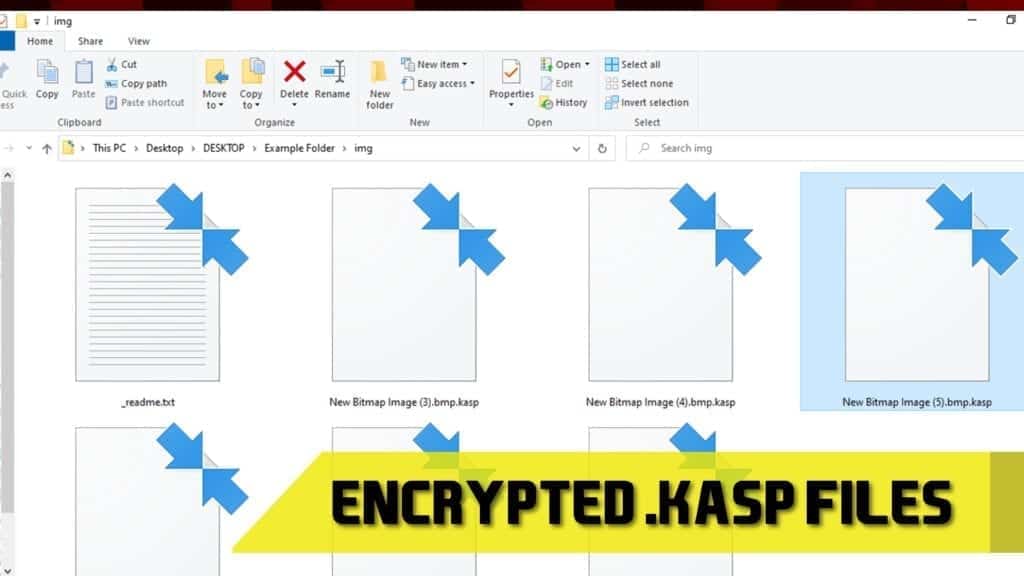
If you want to protect your computer from crypto-malware attacks, you should stop browsing on unverified websites and clicking on various advertisements online. Also, you must only download applications from official websites and never visit illegal file-sharing pages. Finally, pay attention to the emails you receive — if you have not expected a letter, refrain from opening it or at least do not click on any attachments or links inside.
Remove KASP ransomware virus now
The only way to remove KASP ransomware virus and protect your system is to get a robust malware removal software. Keep in mind that there are numerous product offerings. Although, we suggest choosing the one that is robust enough to deal with such dangerous cyber threats as file-encrypting viruses. Our experts recommend RESTORO for the elimination procedure.
Since some STOP/DJVU variants might block the access to security pages or even antivirus tools, you must boot your computer into Safe Mode before you start KASP file virus removal. It is a relatively easy process that is explained in the instructions below. Once you finish the ransomware elimination, you can start restoring encrypted files from backups or try alternative methods.
OUR GEEKS RECOMMEND
Our team recommends a two-step rescue plan to remove ransomware and other remaining malware from your computer, plus repair caused virus damage to the system:
GeeksAdvice.com editors select recommended products based on their effectiveness. We may earn a commission from affiliate links, at no additional cost to you. Learn more.
KASP ransomware virus Removal Guidelines
Method 1. Enter Safe Mode with Networking
Step 1. Start Windows in Safe Mode with Networking
Before you try to remove KASP ransomware virus virus, you must start your computer in Safe Mode with Networking. Below, we provide the easiest ways to boot PC in the said mode, but you can find additional ones in this in-depth tutorial on our website – How to Start Windows in Safe Mode. Also, if you prefer a video version of the tutorial, check our guide How to Start Windows in Safe Mode on Youtube.
Instructions for Windows XP/Vista/7 users
- First of all, turn off your PC. Then press the Power button to start it again and instantly start pressing F8 button on your keyboard repeatedly in 1-second intervals. This launches the Advanced Boot Options menu.
- Use arrow keys on the keyboard to navigate down to Safe Mode with Networking option and press Enter.

Instructions for Windows 8/8.1/10/11 users
- Open Windows Start menu, then press down the Power button. On your keyboard, press down and hold the Shift key, and then select Restart option.

- This will take you to Windows Troubleshoot screen. Choose Troubleshoot > Advanced Options > Startup Settings > Restart. Tip: If you can't find Startup Settings, click See more recovery options.

- In Startup Settings, press the right key between F1-F9 to enter Safe Mode with Networking. In this case, it is the F5 key.

Step 2. Remove files associated with the virus
Now, you can search for and remove KASP ransomware virus files. It is very hard to identify files and registry keys that belong to the ransomware virus, Besides, malware creators tend to rename and change them repeatedly. Therefore, the easiest way to uninstall such type of a computer virus is to use a reliable security program such as INTEGO Antivirus. For virus damage repair, consider using RESTORO.
Special Offer
Compatibility: Microsoft Windows
See Full Review
RESTORO is a unique PC Repair Tool which comes with an in-built Avira scan engine to detect and remove spyware/malware threats and uses a patented technology to repair virus damage. The software can repair damaged, missing or malfunctioning Windows OS files, corrupted DLLs, and more. The free version offers a scan that detects issues. To fix them, license key for the full software version must be purchased.
Method 2. Use System Restore
In order to use System Restore, you must have a system restore point, created either manually or automatically.
Step 1. Boot Windows in Safe Mode with Command Prompt
Instructions for Windows XP/Vista/7 users
- Shut down your PC. Start it again by pressing the Power button and instantly start pressing F8 button on your keyboard repeatedly in 1-second intervals. You will see Advanced Boot Options menu.
- Using arrow keys on the keyboard, navigate down to Safe Mode with Command Prompt option and press Enter.

Instructions for Windows 8/8.1/10/11 users
- Launch Windows Start menu, then click the Power button. On your keyboard, press down and hold the Shift key, and then choose Restart option with the mouse cursor.

- This will take you to Windows Troubleshoot screen. Choose Troubleshoot > Advanced Options > Startup Settings > Restart. Tip: If you can't find Startup Settings, click See more recovery options.

- In Startup Settings, press the right key between F1-F9 to enter Safe Mode with Command Prompt. In this case, press F6 key.

Step 2. Start System Restore process
- Wait until system loads and command prompt shows up.
- Type cd restore and press Enter, then type rstrui.exe and press Enter. Or you can just type %systemroot%system32restorerstrui.exe in command prompt and hit Enter.

- This launches System Restore window. Click Next and then choose a System Restore point created in the past. Choose one that was created before ransomware infection.

- Click Yes to begin the system restoration process.
After restoring the system, we recommend scanning the system with antivirus or anti-malware software. In most cases, there won't be any malware remains, but it never hurts to double-check. In addition, we highly recommend checking ransomware prevention guidelines provided by our experts in order to protect your PC against similar viruses in the future.
Alternative software recommendations
Malwarebytes Anti-Malware
Removing spyware and malware is one step towards cybersecurity. To protect yourself against ever-evolving threats, we strongly recommend purchasing a Premium version of Malwarebytes Anti-Malware, which provides security based on artificial intelligence and machine learning. Includes ransomware protection. See pricing options and protect yourself now.

System Mechanic Ultimate Defense
If you're looking for an all-in-one system maintenance suite that has 7 core components providing powerful real-time protection, on-demand malware removal, system optimization, data recovery, password manager, online privacy protection and secure driver wiping technology. Therefore, due to its wide-range of capabilities, System Mechanic Ultimate Defense deserves Geek's Advice approval. Get it now for 50% off. You may also be interested in its full review.

Disclaimer. This site includes affiliate links. We may earn a small commission by recommending certain products, at no additional cost for you. We only choose quality software and services to recommend.
Decrypt KASP files
Fix and open large KASP files easily:
It is reported that STOP/DJVU ransomware versions encrypt only the beginning 150 KB of each file to ensure that the virus manages to affect all files on the system. In some cases, the malicious program might skip some files at all. That said, we recommend testing this method on several big (>1GB) files first.
- Create a copy of encrypted file to a separate folder using Copy > Paste commands.
- Now, right-click the created copy and choose Rename. Select the KASP extension and delete it. Press Enter to save changes.
- In the prompt asking whether you want to make the changes as file might become unusable, click OK.
- Try opening the file.
STOP/DJVU decryption tool usage guide
STOP/DJVU ransomware versions are grouped into old and new variants. KASP ransomware virus is considered the new STOP/DJVU variant, just like JYPO, KIFR, KIOP, KITZ, BOZA, BOTY, COZA (find full list here). This means full data decryption is now possible only if you have been affected by offline encryption key. To decrypt your files, you will have to download Emsisoft Decryptor for STOP DJVU, a tool created and maintained by a genius security researcher Michael Gillespie.
Note! Please do not spam the security researcher with questions whether he can recover your files encrypted with online key - it is not possible.
In order to test the tool and see if it can decrypt KASP files, follow the given tutorial.
- Download the decryption tool from Emsisoft.
- Click the little arrow next to your download and choose Show in Folder.
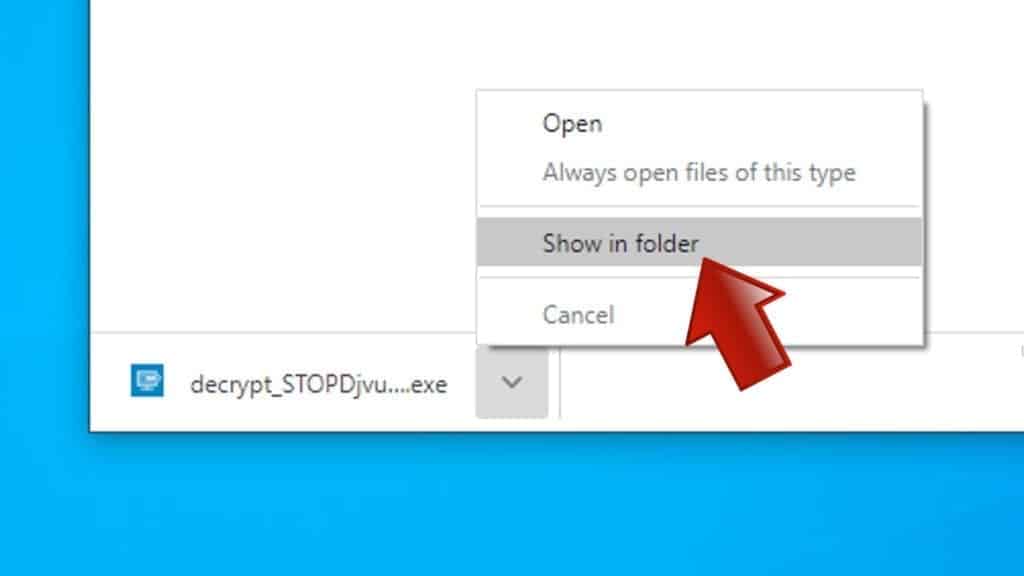
- Now, right-click the file and choose Run as Administrator. If asked, enter administrator's password.
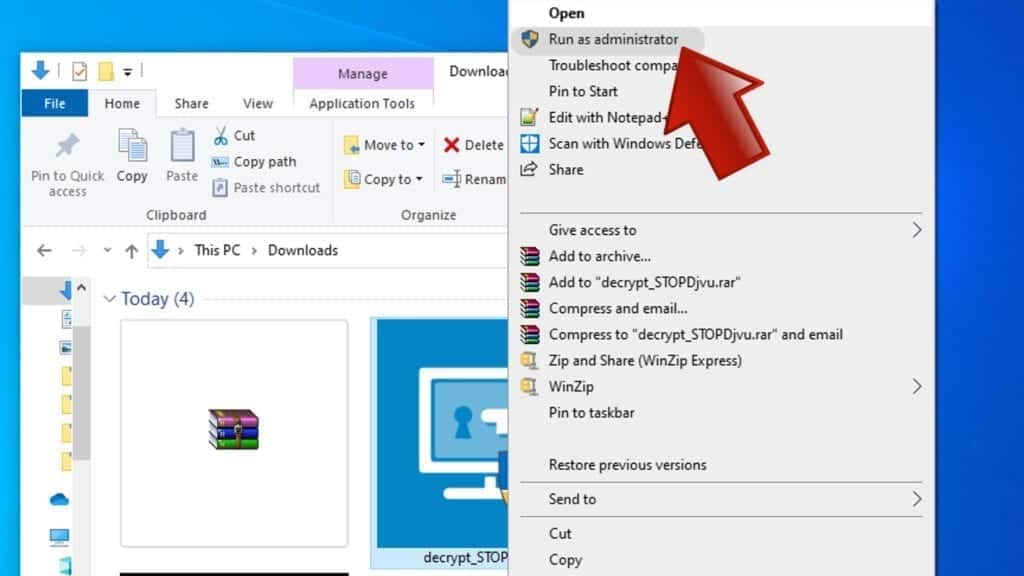
- In UAC window, click Yes.
- Click Yes to agree to software terms in both windows.
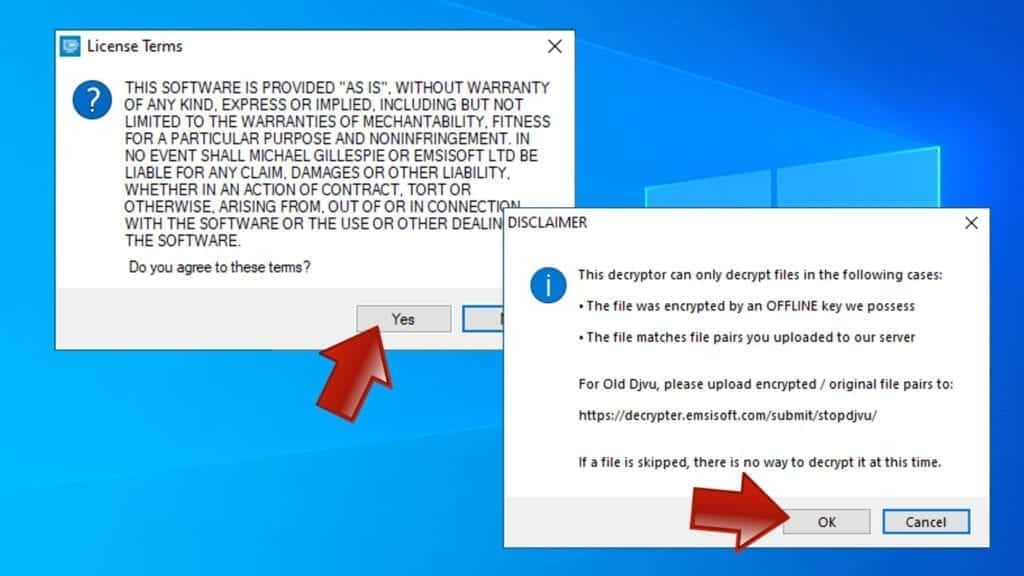
- The tool will automatically include C:// disk as a location to decrypt. The file recovery tool will prepopulate the locations to scan, including connected data storage drives or network drives. Click Add folder if you wish to add additional locations.
In Options tab, you can choose to keep encrypted file copies. We recommend leaving this option selected, especially if you do not know if the decryption tool will work.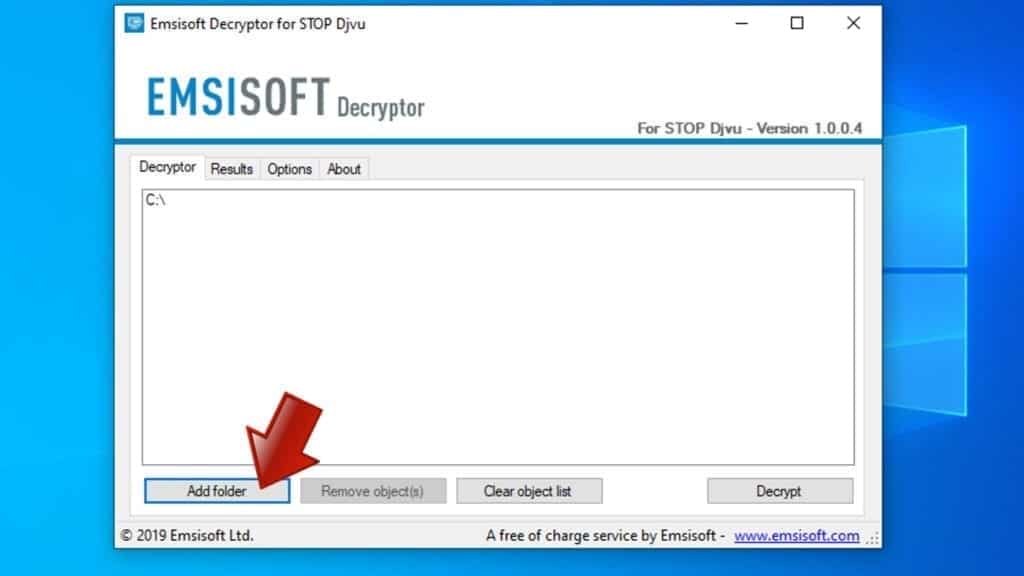
- Click Decrypt to start restoring KASP files. You will see the progress in the Results tab. Here, you can see messages from the tool, such as whether the decryption procedure is successful, or you need to wait for an update.
You might also be informed that online key was used to encrypt your files. In such case, the decryption tool won't work for you, and the only way to recover your files is to use a data backup.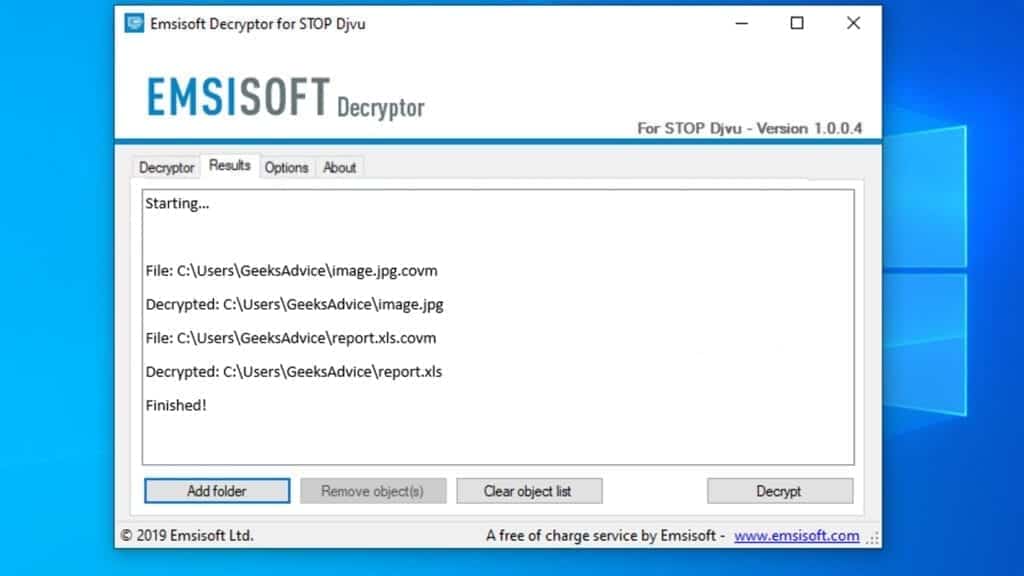
Meanings of decryptor's messages
The KASP decryption tool might display several different messages after failed attempt to restore your files. You might receive one of the following messages:
Error: Unable to decrypt file with ID: [example ID]
This message typically means that there is no corresponding decryption key in the decryptor's database.
No key for New Variant online ID: [example ID]
Notice: this ID appears to be an online ID, decryption is impossible
This message informs that your files were encrypted with online key, meaning no one else has the same encryption/decryption key pair, therefore data recovery without paying the criminals is impossible.
Result: No key for new variant offline ID: [example ID]
This ID appears to be an offline ID. Decryption may be possible in the future.
If you were informed that an offline key was used, but files could not be restored, it means that the offline decryption key isn't available yet. However, receiving this message is extremely good news, meaning that it might be possible to restore your KASP extension files in the future. It can take a few months until the decryption key gets found and uploaded to the decryptor. We recommend you to follow updates regarding the decryptable DJVU versions here. We strongly recommend backing up your encrypted data and waiting.
Report Internet crime to legal departments
Victims of KASP ransomware virus should report the Internet crime incident to the official government fraud and scam website according to their country:
- In the United States, go to the On Guard Online website.
- In Australia, go to the SCAMwatch website.
- In Germany, go to the Bundesamt für Sicherheit in der Informationstechnik website.
- In Ireland, go to the An Garda Síochána website.
- In New Zealand, go to the Consumer Affairs Scams website.
- In the United Kingdom, go to the Action Fraud website.
- In Canada, go to the Canadian Anti-Fraud Centre.
- In India, go to Indian National Cybercrime Reporting Portal.
- In France, go to the Agence nationale de la sécurité des systèmes d’information.
If you can't find an authority corresponding to your location on this list, we recommend using any search engine to look up "[your country name] report cyber crime". This should lead you to the right authority website. We also recommend staying away from third-party crime report services that are often paid. It costs nothing to report Internet crime to official authorities.
Another recommendation is to contact your country's or region’s federal police or communications authority.
Frequently Asked Questions
You can only open KASP files if you have the decryption key, or if you were affected by offline encryption type.
To figure out whether you were affected by offline encryption, please go to C:/SystemID/PersonalID.txt and see if the string inside of it ends in t1. You can also try using Emsisoft Decryptor for STOP/DJVU.
Please follow the guidances provided by the official KASP decryption tools and believe what they say. If they say it is impossible to decrypt, it really is so. There is no magic tool or human capable of decrypting your files hiding somewhere. Encryption is a technique created to be nearly impossible to decrypt without a special private key (held by the criminals).
We advise scanning with anti-virus, anti-malware, malware removal tools or software like RESTORO to eliminate virus damage on the system. If you do not trust using a single tool, try running one after another. However, we do not recommend keeping several security programs on a computer at once as they can interfere with each other's work.
Beware of fake KASP decryption tools circulating around the web. Cyber criminals are uploading them to various shady websites, also might be promoting them via suspicious Youtube videos. These programs can infect your computer even more heavily (Trojans, miners, etc.). We suggest being extremely cautious around the web. If there will be an official STOP/DJVU decryption tool available, it will be widely discussed in public media.

Scott Bolton is a senior content strategist in our Geek’s Advice team. He is exceptionally passionate about covering the latest information technology themes and inspire other team members to follow new innovations. Despite the fact that Scott is an old-timer among the Geeks, he still enjoys writing comprehensive articles about exciting cybersecurity news or quick tutorials.
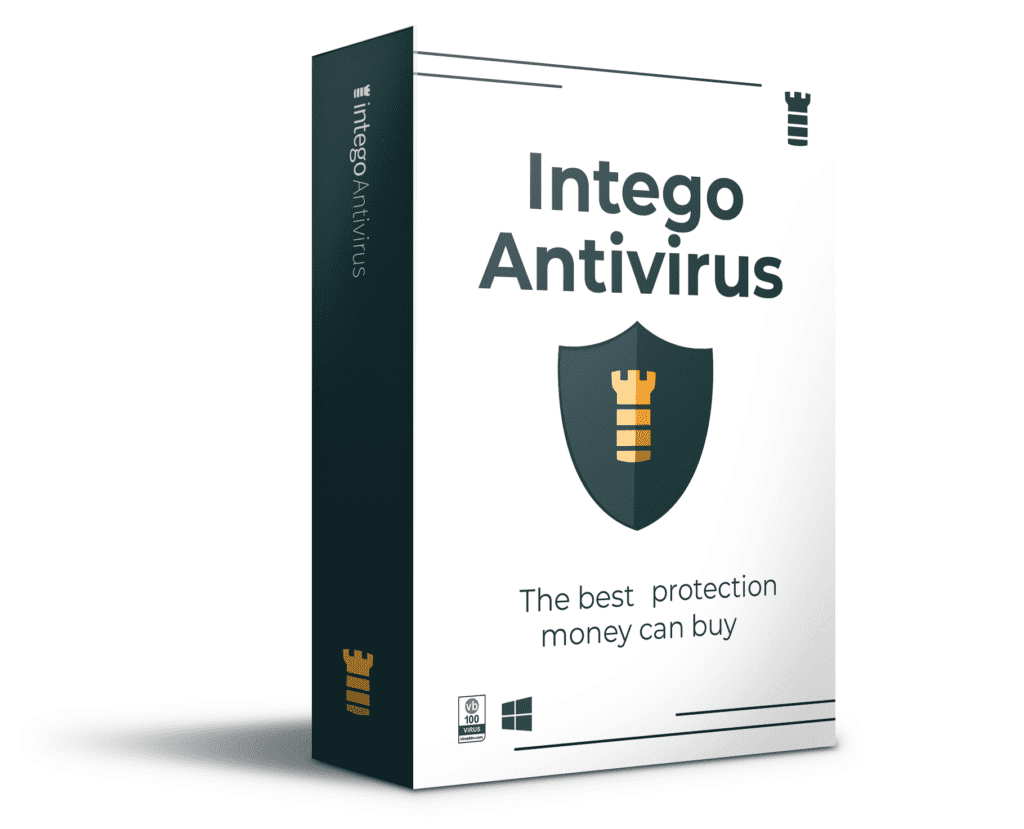
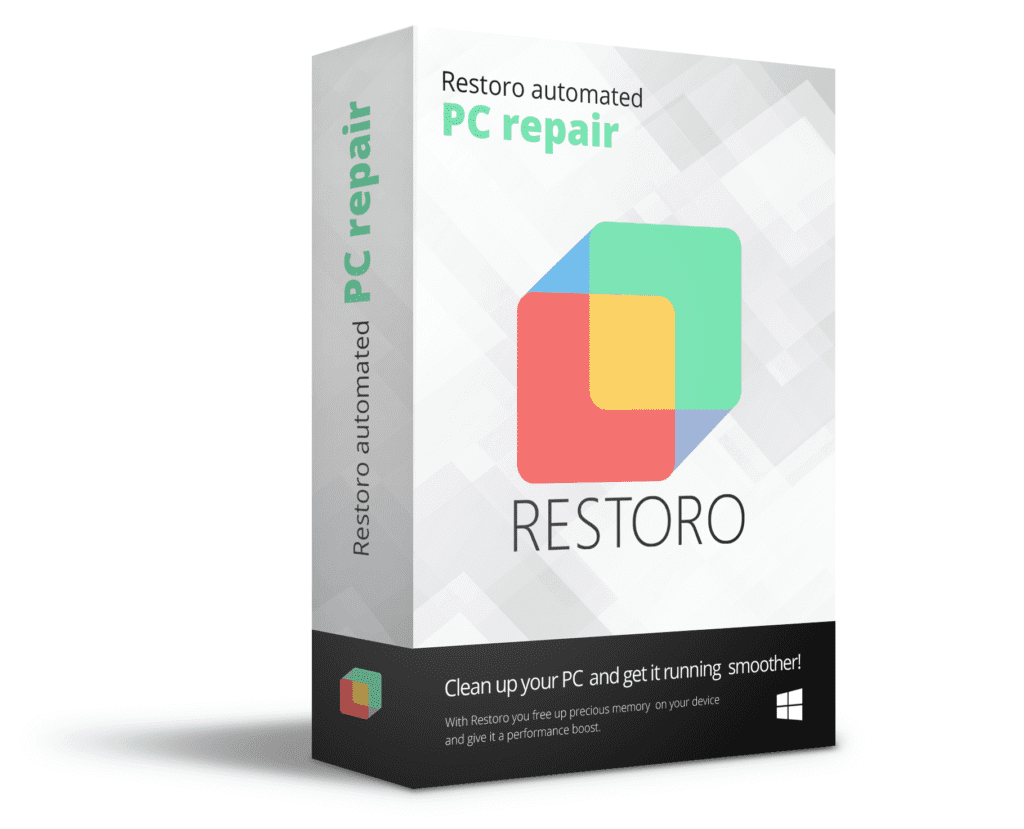
I am so frustrated I was trying to use kmspico and this kasp virus damaged the whole system! so unexpected and had to waste half a day to recover my files. useful instructions to remove the malware – thanks so much.
The ONLY useful guide out there! Thanks for explaining what happened. I will never download software cracks again. Currently running the recommended software!